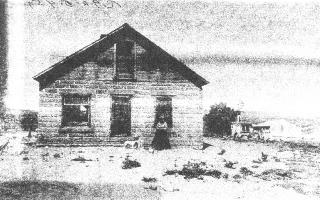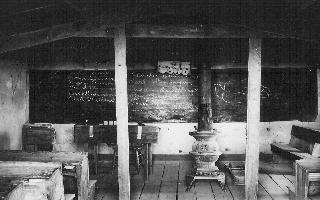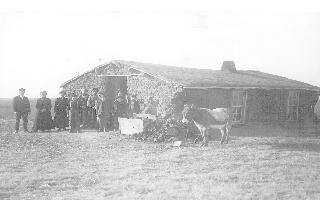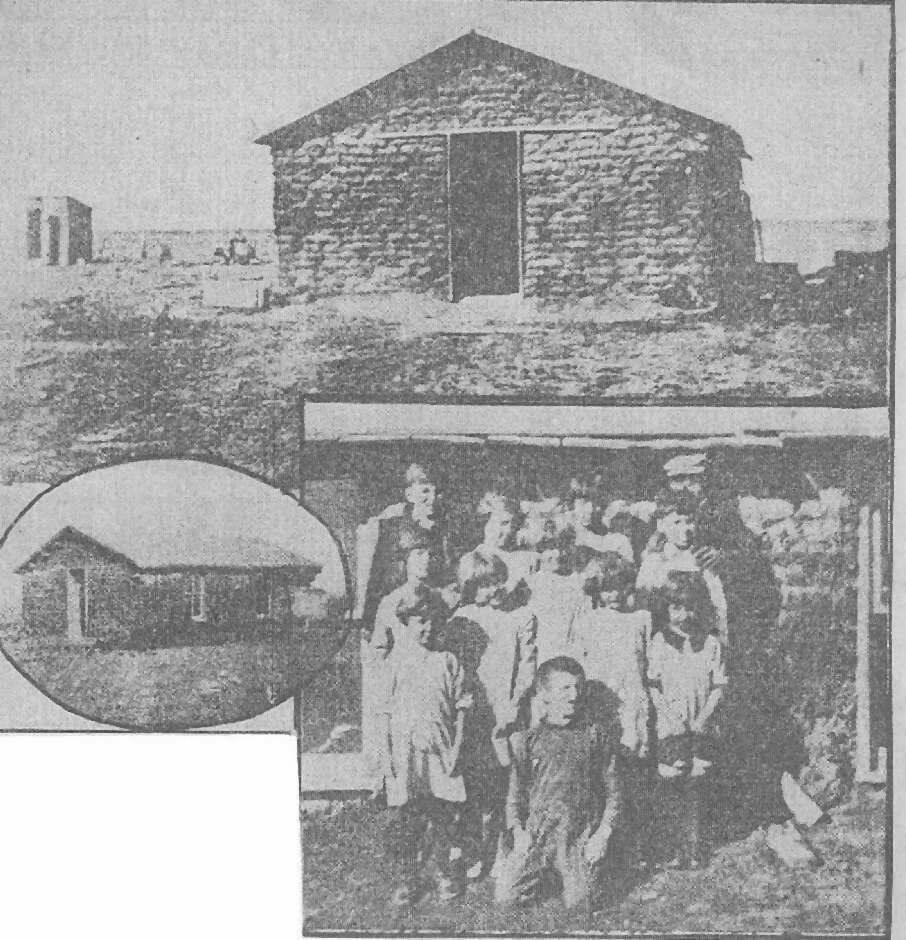|
|
Welcome to Wichita County KSGenWeb |
Return to Wichita County Main Page
|
SCHOOL DAYS - Western Kansas 1880's & 1890's Children started to school at the age of five. A school term was from three to six months. If one district's school was out earlier than a neighboring school; the older pupils would often go to the other district school until its school closed. The pupils usually walked to school. They tried to have the school house centrally located for the children's convenience. For this reason they sometimes moved the school house. The younger children went to school barefooted in nice weather. If a person was eighteen year sold and passed the teacher's examination to obtain a third grade certificate, they they could teach. The county superintendent would not issue but two third grade certificates to any one person. If one expected to continue teaching they had to pass the examination for a second grade certificate. The second grade certificate would have to be renewed at intervals; but so long as one passed the examination they could continue to teach. The first grade certificate was a life certificate. A special effort was made to teach reading, writing, spelling, and arithmetic. We also studied U.S. History, Kansas History, Physiology, Grammar and Geography. Some of the arithmetic which we studied in the eighth grade is now taught in the high schools. In the lower grades spelling was taught orally. The students would stand in a row while the teacher would pronounce the word. If the first student misspelled it the next student would try. If he spelled it correctly he would change places with the one that had missed the word; so he would be at the head of the row. When the time was up the first student of the row would get a headmark and then move to the foot of the class. Most of our teachers had second grade certificates and were good instructors. My first term of school was a four month term. The one room building was a mile from home. Since we had no desks we sat on benches. That summer our district, “Sunnyside,” built a larger schoolhouse, bought desks and a small bell. They made a large blackboard. We had one old maid teacher :Miss Libby,” whom the boys did not like. My brother Jim and his pal, Hiram Burr, herded the two families cattle taking turns every other week. The one at school always knew what the other one was going to do. The one that was herding would slip up to the school house, a frame building, with sod covering the sides to make it warmer, climb on top of the building, put sod on the stove pipe to cut the draft off and then return to the cattle. Miss Libby would work with the stove, raise the windows and open the door, but the fire kept puffing the smoke out into the room. When the boy in the school room had had enough fun he would ask to be excused, go outside and remove the clod. This happened a good many times before Miss Libby realized it was just a prank. They moved the school house one and one half miles northwest. My oldest sister Lilly taught a four month term there. We then went to Badger Den District, walking two and three quarter miles to school. It was half dugout, the other half was walled up with sod. This school was infested with stink bugs and the younger pupils would hurt them so that the bug would emit a terrible odor, just to tease the older students. Later we moved ten miles south and had an old maid for a teacher, Miss Patty. She must have been at least sixty-five years old. Miss Patty would wear two pairs of glasses. There were no bifocals at that time. In those days the frames did not hook around the ears, so Miss Patty would fasten strings to the bows and tie them in the back. Sometimes she would be looking everywhere for one pair and they would be pushed up on her forehead. Miss Patty wore wool skirts so frayed at the bottom the lining showed. Her corset had real long strings in it; Sometimes they would become untied and drag three or four inches behind her. A mischievous boy would crawl behind her, raise up the strings and act silly. The rest of the children were choking to keep from laughing out loud, she never caught the joker. One day while she was scolding another pupil, I looked up with a scowl on my face. She forgot about the boy and began to scold me. I just laughed so she made me take my geography book and go stand by her desk. On the way she was trying to shake me but she wasn't strong enough to do so. When we got close to the coal scuttle, I let the shaking take effect. My foot hit the scuttle, knocked it over and spilled the coal. When she wasn't looking I peaked around my book and made the other children laugh. I attended one nine month term of school at Liberal, Kansas. The rest were from three to six months. I attended Normal School one month at Liberal, Kansas and two months at Beaver City, Oklahoma. I taught one nine month term at Tyrone, Oklahoma. The above was written by Emma Powell Wahl, who went to school in Wichita County when sod schoolhouses were common. |
|
|
This is a picture of Maggie Patty, or perhaps better known as "Miss Patty" to the children whom she taught for years. Homesteading in this county in 1886 on the location known today as the Kreutzer place, she never married and lived on the old home site about five miles south of Leoti. She was an aunt of Galen Robison of this city. |
|
Last Sod School House In Kansas Is “Modernized” A relic of the early eighties, a sod schoolhouse in which the children of the pioneers of Wichita County were first taught readin', writin', and 'rithmetic, still stands of the wide prairie 13 miles northwest of Leoti, the county seat. The schoolhouse which was erected in the eighties has stood the roughness of the storms of the years, and is now being covered with cement to keep alive the memories of the early days when lumber was a luxury and the howl of the coyote was the music of the prairies. The school was established in the wild and wooly days of Wichita County, which was established as a county in 1873 and named for the Wichita Indians. Prior to 1885 there were only seven dwelling houses in Wichita County, and these belonged to cattlemen. There were no schoolhouses, and but few children to attend, had there been one. But, the settlement was so rapid during 1885 and 1886 that in the latter year the governor appointed W.D. Brainard to take the census. At that time Leoti was the chief trading point, with a larger population than any other town. A company of professional speculators, located at Coronado, a few miles to the east, built some fine business blocks and began trying to make their town the county seat. In order to do this they had to have time in which to work, and in some unknown way they managed to delay the return of the census. The census and petitions did not reach the governor for a long time, and when they did they were so mutilated that he was unable to tell which town was the choice of the people. He appointed a commission to hold an election. The books were opened in the sod schoolhouse southeast of Leoti. Each side insisted on a thorough test poll, and the voting took three weeks. Feeling ran high and from the first every man was armed. At times as many at 200 armed men surrounded the schoolhouse and it was only by considerable tact by the cooler heads that a general slaughter was avoided. Governor Martin issued his proclamation on Dec. 24, and Leoti, having received a large majority of the votes, was made the temporary county seat. The sod house which has withstood the ravages of time, was built by the early settlers who rushed to the western section of the state in 1875-6. There was no money in the county treasury to build schoolhouses, and the men of the territory for miles around met with teams, wagons and spades, dug up the sod and built the first school in Wichita County. It has been used continuously since first built. The sun and the rain have beat upon the old sod building for many years, and walls and roofs are showing the marks of the years, but the citizens of the district 13 miles northwest of Leoti have decided to preserve the old sod building. It will be treated to a coat of stucco, and the chances are the famous old sod shanty will be a relic of the past for many years to come. The picture shows the student body in 1925-26, when there were 13 student in attendance. The school for these two years was taught by Miss Mary Langley. |
|
Wide Awake Dist. #13 |
|
This picture tells the story quite well of what the pioneer children had to work with in order to get an education. Take note of the home made desks, the recitation desk, the slate-cloth blackboard that krinkled as it was pasted over the rough plastered wall. The old potbellied stove with the coal scuttle setting near by. The teacher's desk that lacked the modesty panel, the day of long dresses made them less important. The after thought roof supports standout as being very necessary. |
|
|
|
Notice the coal pile and coal box. The sod chimney stands out as something special! The crop-eared burro belonged to Ben Barrows. Fred Lipper - teacher. Students - Margaret Lipper, Orpha Barrows, Elsie Wallace, Ben Barrows, Bertha Lipper, Ruth Eichenberger, Tena Eichenberger, Lawrence Eichenberger, Charley Eichenberger, Maude Eichenberger, Maude Weininger. |
|
|
Kansas' Last Sod Schoolhouse The last sod schoolhouse in Kansas is being madernized. Located on the prairie 13 miles northwest of Leoti, county seat of Wichita County, the little sod building is being given a coat of concrete to help it withstand the ravages of time and weather. The upper picture is a closeup of the front of the schoolhouse. The inset is another view of the building. The group shown is the schoolbody in 1925-1926, when 13 students were enrolled. At that time the child living closest to the school had to walk two miles to get to it, and each student had to carry a jar of water to school with him as there was no well. |
|
War in Wichita County By Karen Walk Many County Seat Fights were fought in the settling of the West. But, perhaps the most picturesque, bloody, dramatic, and long drawn-out of all was the "War" between the towns of Leoti and Coronado, just 2 ½ miles apart, in Wichita County, in western Kansas. In 1886, formal procedures were taken to organize the county. Governor Martin was petitioned, and appointed a census-taker to poll the actual number of legal voters in the county, as well as each opposing town, with a view of calling a temporary election, selecting county officers, and naming a county seat. Both towns of Leoti and Coronado grew very rapidly. Hotels, business houses, and homes were quickly erected. Immediately, a bitter strife developed, based on mutual efforts to secure the vital county seat. Week after week, rival editors indulged in abusive editorials in their newspapers, which added fuel to the fire that was beginning to burn. Leoti had sent a "Macedonian" call to Wallace, in a nearby county, for a band of fifteen armed cowboys. Finding idle time on their hands, they began shooting up the town of Leoti, riddling the post office and business places with bullets and compelling the business-men to dance the can-can or do an Irish jig on Main Street. On February 8, 1887, the fraudulent, temporary election was held with many votes bought at $50 a head. Voting lists were filled with non-resident and fictitious voter names. Many were intimidated and kept away from the polling places by gangs of "hired cowboys and thugs". Leoti having won this election, was declared temporary county seat. Writs were issued for a regular permanent election and the date set for March 10, 1887. With Politics now entering the situation, the legislature, courts, attorney general and the governor were all more or less entangled. Tension was extreme and excitement at fever pitch between the two rival towns. A spark sufficed for a general explosion. On a quiet Sunday, February 27, 1887, just two weeks before the election, the contest culminated in open, bloody warfare on the Main street of Coronado. A group of seven Leoti men jumped into a buckboard wagon, with liquor and rifles, then headed to Coronado for a little "fun." The rest is history. After roughing up the town, one gunshot was fired and soon an all-out battle entailed. A hail of Winchester bullets from the rifles of Coronado men from upper windows and doorways made the visitors run for their buckboard and head for home. Most of the victims fell from the wagon into the street. Of the Leoti party, Charlie Coulter, an ex-Quantrill raider, William Raines, and George Watkins were killed instantly and lay in the street. Two of the men escaped with the runaway team. Frank Jenness, shot 6 times, died later. Albert Boorey was so riddled with bullets, it was a miracle he lived. A.R. Johnson lay on the street with a bullet in the head. Emmet Denning was hit in the leg and injured so badly it was later amputated. That evening, the wires to Topeka blazed with frantic calls from the county sheriff to the governor. The Kansas Militia ordered the Sterling and Larned Companies to Garden City, equipped for action. Rifle-pits were dug and occupied around the town hall of Leoti. An armed guard of Dodge City lawmen had also been posted around Coronado to prevent the escape of any of the suspected killers, before the arrival of the military. Among these were Bill Tilghman, Pat Sughrue, Wyatt Earp, Bat Masterson and others. Upon his arrival with the military, Colonel Ricksecker and County Sheriff Edwards rode to Coronado and warned the militant Coronado-ans that he had two companies of state militia, armed, and in a bad humor. He suggested they lay down their arms and surrender. In all, twenty- one men were charged and arrested of murder in the first degree. The large number of prisoners were confined in the Dodge City, Garden City, and Hays City jails. Nearly a year later, the trials of the accused Coronado men came up in Great Bend, on a change of venue. The cases were bitterly contested. The two towns had such conflicting stories of the incident, that all of the 21 men were acquitted of all charges, on lack of evidence. As a result of the final election, held on March 10, 1887, Leoti was declared the permanent county seat of Wichita County. In a remarkably short time, all bitterness between the two rival, prairie towns was forgotten and forgiven. Leoti, to show no hard feelings, offered free town lots to Coronado people and soon they were moving, lock, stock and barrel, even the buildings. |
Return to Wichita County Main Page
[ Cemeteries ] [Contact Us ] [Genealogy Society ] [ Links] [Lookups ] [Marriages] [Obituaries ] [ Queries ] [USGen Web Archives ] [ KSGenWeb Digital Library ] [ Photos ] [ Stories ] [ Surnames ] [Resources]
KSGenWeb logo was designed and is copyrighted by Tom & Carolyn Ward for the limited use of the KSGenWeb Project. Permission is granted for use only on an official KSGenWeb page. The USGenWeb Logo was designed by Linda Cole.
Updated on 02/05/04
|
County Hosted by Jeanene French, Leoti jrfrench@wbsnet.org |
AND
|





